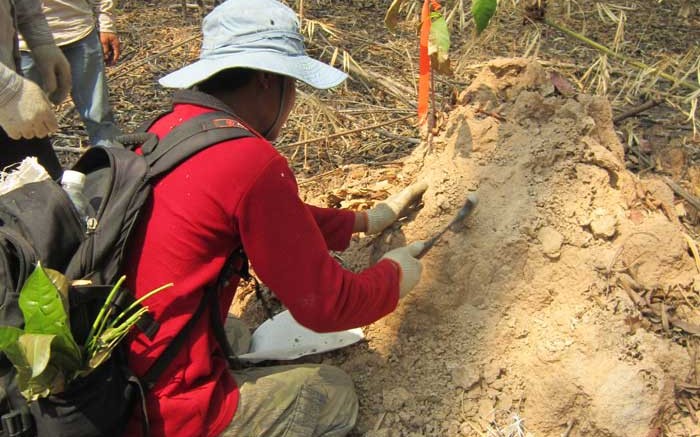A prospect Angkor Gold (TSXV: ANK; US-OTC: ANKOF) picked up in northeastern Cambodia in 2012 may soon become the country’s first modern, commercial gold mine, president and CEO Mike Weeks says.
The project generator sold the 12 sq. km Phum Syarung prospect on its 300 sq. km Oyadao South Concession to Mesco Gold — a subsidiary of Indian steelmaker Mesco — for US$1.2 million in March 2013.
Angkor retains a 7.5% net smelter return royalty on all production from Phum Syarung if the monthly average gold price is between US$1,300 and US$1,700 per oz. If the gold price dips below US$1,300 per oz., the royalty slides by 0.5% for each US$50 in the gold price and rises 0.5% for each US$50 price above US$1,700.
Mesco Gold submitted its mining application for Phum Syarung to Cambodia’s Ministry of Industry, Mines and Energy in January, and Weeks says he expects the Indian mining company will have the permit approved before the end of June.
“They are already in the development phase and hope to process ore in late 2015,” Weeks says, adding that in India, mining companies do not need proven and probable reserves to build a mine.
“They’re going to mine it and be ready to expand, because they believe, like we do, that it’s a big resource,” Weeks says. “At the very least the resource is big enough for them and us to be profitable, and they think it’s a lot bigger. They’ve found three veins down to 100 metres, and believe there is a lot more below that.”
Weeks estimates that an underground mine built at Phum Syarung could produce 10,000 oz. gold a year over a 10-year mine life, and estimates that capex could be $8 million.
“This will be the first legally operated mine in Cambodia, and it will be the first of many,” he says.
“There aren’t any North American companies operating in Cambodia yet, but there are a number of Australian ones, such as Renaissance Minerals, which has a 1.2 million oz. gold resource. We think mining companies are going to look at Cambodia the way they looked at Colombia several years ago.”
Selling Phum Syarung to Mesco Gold followed selling an 80 km prospect in January 2013 on its Oyadao South Concession to private Chinese company Canxiang Mining for US$2.4 million. Angkor did not retain a royalty on the deal.
Angkor Gold has seven licences in the country covering 1,450 sq. km — most of them on the eastern side of Cambodia, close to the border with Vietnam — and is signing strategic agreements on some of them.
In April it signed a $10.5-million definitive agreement with a Chinese equity fund based in the city of Chengdu, and incorporated in Hong Kong under Tohui Beishan Property Group Holding Ltd.
Tohui brings a consortium of associates, including Beijing Explo-Tech Engineering Co. (BETEC) Ltd., and the China Chemical Geology and Mine Bureau Shandong Geological Prospecting Institute (SGI).
Weeks describes BETEC and SGI as having specialized equipment, 20 highly skilled Chinese geophysicists and five Chinese geologists.
“This agreement will help us cut our exploration time down by years,” Weeks says, adding that the Chinese equity fund transaction with Angkor Gold took about eight months of due diligence, much of it in China.
Weeks says the expanded exploration program includes a geophysical survey program over 25 sq. km, and focuses on two areas: Wild Boar and China Wall.
Soon after Angkor acquired the property in April 2012, three scout diamond drill holes totalling 521 metres on the China Wall prospect returned intercepts of 6.13 grams silver per tonne over 18.7 metres, 15.98 grams silver per tonne over 20.4 metres and 14.52 grams silver per tonne over 7.5 metres.
At the Wild Boar prospect, induced polarization (IP) and geochemical work is targeting several polymetallic quartz-carbonate veins, which have extensive artisanal workings and grab-samples assaying 3.22 grams gold per tonne to 13.58 grams gold per tonne.
BETEC and SGI will send a six-person team of earth scientists to extend IP and geological work east of where work was completed on Angkor Gold’s Okalla prospect in the Banlung exploration-licence area. The team will cover 15 sq. km, and look for drill targets later this year.
Drilling should start in June, or after the rainy season, which runs from July to October.


Be the first to comment on "Angkor Gold presses ahead in Cambodia"